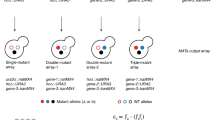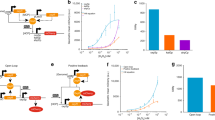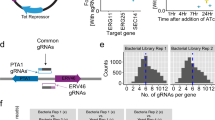Abstract
The analysis of synthetic genetic interaction networks can reveal how biological systems achieve a high level of complexity with a limited repertoire of components. Studies in yeast and bacteria have taken advantage of collections of deletion strains to construct matrices of quantitative interaction profiles and infer gene function. Yet comparable approaches in higher organisms have been difficult to implement in a robust manner. Here we report a method to identify genetic interactions in tissue culture cells through RNAi. By performing more than 70,000 pairwise perturbations of signaling factors, we identified >600 interactions affecting different quantitative phenotypes of Drosophila melanogaster cells. Computational analysis of this interaction matrix allowed us to reconstruct signaling pathways and identify a conserved regulator of Ras-MAPK signaling. Large-scale genetic interaction mapping by RNAi is a versatile, scalable approach for revealing gene function and the connectivity of cellular networks.
This is a preview of subscription content, access via your institution
Access options
Subscribe to this journal
Receive 12 print issues and online access
$259.00 per year
only $21.58 per issue
Buy this article
- Purchase on Springer Link
- Instant access to full article PDF
Prices may be subject to local taxes which are calculated during checkout





Similar content being viewed by others
References
Farha, M.A. & Brown, E.D. Chemical probes of Escherichia coli uncovered through chemical-chemical interaction profiling with compounds of known biological activity. Chem. Biol. 17, 852–862 (2010).
Collins, S.R. et al. Functional dissection of protein complexes involved in yeast chromosome biology using a genetic interaction map. Nature 446, 806–810 (2007).
Costanzo, M. et al. The genetic landscape of a cell. Science 327, 425–431 (2010).
Bakal, C. et al. Phosphorylation networks regulating JNK activity in diverse genetic backgrounds. Science 322, 453–456 (2008).
Bruckner, K. et al. The PDGF/VEGF receptor controls blood cell survival in Drosophila . Dev. Cell 7, 73–84 (2004).
Sims, D., Duchek, P. & Baum, B. PDGF/VEGF signaling controls cell size in Drosophila . Genome Biol. 10, R20 (2009).
Tong, A.H. et al. Global mapping of the yeast genetic interaction network. Science 303, 808–813 (2004).
Lehar, J. et al. Synergistic drug combinations tend to improve therapeutically relevant selectivity. Nat. Biotechnol. 27, 659–666 (2009).
Horn, T., Sandmann, T. & Boutros, M. Design and evaluation of genome-wide libraries for RNA interference screens. Genome Biol. 11, R61 (2010).
Ridley, A.J. Rho GTPases and actin dynamics in membrane protrusions and vesicle trafficking. Trends Cell Biol. 16, 522–529 (2006).
Yu, J., Pacifico, S., Liu, G. & Finley, R.L. Jr. DroID: the Drosophila Interactions Database, a comprehensive resource for annotated gene and protein interactions. BMC Genomics 9, 461 (2008).
McPherson, P.S., Takei, K., Schmid, S.L. & De Camilli, P. p145, a major Grb2-binding protein in brain, is co-localized with dynamin in nerve terminals where it undergoes activity-dependent dephosphorylation. J. Biol. Chem. 269, 30132–30139 (1994).
Friedman, A. & Perrimon, N. A functional RNAi screen for regulators of receptor tyrosine kinase and ERK signalling. Nature 444, 230–234 (2006).
Chen, H.W. et al. CKA, a novel multidomain protein, regulates the JUN N-terminal kinase signal transduction pathway in Drosophila . Mol. Cell. Biol. 22, 1792–1803 (2002).
Reich, A., Sapir, A. & Shilo, B. Sprouty is a general inhibitor of receptor tyrosine kinase signaling. Development 126, 4139–4147 (1999).
Wassarman, D.A. et al. Protein phosphatase 2A positively and negatively regulates Ras1-mediated photoreceptor development in Drosophila . Genes Dev. 10, 272–278 (1996).
Ory, S., Zhou, M., Conrads, T.P., Veenstra, T.D. & Morrison, D.K. Protein phosphatase 2A positively regulates Ras signaling by dephosphorylating KSR1 and Raf-1 on critical 14–3-3 binding sites. Curr. Biol. 13, 1356–1364 (2003).
Goudreault, M. et al. A PP2A phosphatase high density interaction network identifies a novel striatin-interacting phosphatase and kinase complex linked to the cerebral cavernous malformation 3 (CCM3) protein. Mol. Cell. Proteomics 8, 157–171 (2009).
Ribeiro, P.S. et al. Combined functional genomic and proteomic approaches identify a PP2A complex as a negative regulator of Hippo signaling. Mol. Cell 39, 521–534 (2010).
Byrne, A.B. et al. A global analysis of genetic interactions in Caenorhabditis elegans . J. Biol. 6, 8 (2007).
Lehner, B., Crombie, C., Tischler, J., Fortunato, A. & Fraser, A.G. Systematic mapping of genetic interactions in Caenorhabditis elegans identifies common modifiers of diverse signaling pathways. Nat. Genet. 38, 896–903 (2006).
Luo, J. et al. A genome-wide RNAi screen identifies multiple synthetic lethal interactions with the Ras oncogene. Cell 137, 835–848 (2009).
Mani, R., St Onge, R.P., Hartman, J.L.t., Giaever, G. & Roth, F.P. Defining genetic interaction. Proc. Natl. Acad. Sci. USA 105, 3461–3466 (2008).
Baryshnikova, A. et al. Quantitative analysis of fitness and genetic interactions in yeast on a genome scale. Nat. Methods 7, 1017–1024 (2010).
Casey, F.P., Cagney, G., Krogan, N.J. & Shields, D.C. Optimal stepwise experimental design for pairwise functional interaction studies. Bioinformatics 24, 2733–2739 (2008).
Battle, A., Jonikas, M.C., Walter, P., Weissman, J.S. & Koller, D. Automated identification of pathways from quantitative genetic interaction data. Mol. Syst. Biol. 6, 379 (2010).
Manolio, T.A. et al. Finding the missing heritability of complex diseases. Nature 461, 747–753 (2009).
Dowell, R.D. et al. Genotype to phenotype: a complex problem. Science 328, 469 (2010).
Shao, H. et al. Genetic architecture of complex traits: large phenotypic effects and pervasive epistasis. Proc. Natl. Acad. Sci. USA 105, 19910–19914 (2008).
Tweedie, S. et al. FlyBase: enhancing Drosophila Gene Ontology annotations. Nucleic Acids Res. 37, D555–D559 (2009).
Boutros, M. et al. Genome-wide RNAi analysis of growth and viability in Drosophila cells. Science 303, 832–835 (2004).
Steinbrink, S. & Boutros, M. RNAi screening in cultured Drosophila cells. Methods Mol. Biol. 420, 139–153 (2008).
Han, K. An efficient DDAB-mediated transfection of Drosophila S2 cells. Nucleic Acids Res. 24, 4362–4363 (1996).
Arvidsson, S., Kwasniewski, M., Riano-Pachon, D.M. & Mueller-Roeber, B. QuantPrime–a flexible tool for reliable high-throughput primer design for quantitative PCR. BMC Bioinformatics 9, 465 (2008).
Norton, B. & Pearson, E.S. A note on the background to and refereeing of R.A. Fisher's 1918 paper. Notes Rec. R. Soc. Lond. 31, 151–162 (1976).
Lönnstedt, I. & Speed, T.P. Replicated microarray data. Statist. Sinica 12, 31–46 (2002).
Smyth, G.K. Linear models and empirical bayes methods for assessing differential expression in microarray experiments. Stat. Appl. Genet. Mol. Biol. 3, 3 (2004).
Storey, J.D. & Tibshirani, R. Statistical significance for genomewide studies. Proc. Natl. Acad. Sci. USA 100, 9440–9445 (2003).
Weng, L. & Du, W. Role of Cka in imaginal disc growth and differentiation. Drosoph. Inf. Serv. 85, 8–12 (2002).
Acknowledgements
We thank A.-C. Gavin, A. Teleman and F. Markowetz for helpful comments on the manuscript, N. Perrimon (Harvard Medical School), W. Du (University of Chicago) and S. Hou (National Cancer Institute–Frederick) for sharing reagents and fly stocks, members of the Drosophila Genomics Resource Center for providing plasmids, members of the Bloomington Drosophila stock center for fly stocks and the information technology Service Units of the European Molecular Biology Laboratory and the German Cancer Research Center, for technical support; and A. Kiger and R. Gentleman for helpful discussions. The work was supported in part by a fellowship of the Studienstiftung (T.H.), the CellNetworks Cluster of Excellence (T.S.), a program grant of the Human Frontiers Sciences Program (W.H. and M.B.) and the EU FP7 project CancerPathways (W.H. and M.B.).
Author information
Authors and Affiliations
Contributions
T.H., T.S., B.F., W.H. and M.B. designed the study; T.H. and T.S. performed the experiments; B.F. analyzed the data; E.A. performed initial analyses; T.S., T.H., B.F., W.H. and M.B. wrote the manuscript.
Corresponding authors
Ethics declarations
Competing interests
The authors declare no competing financial interests.
Supplementary information
Supplementary Text and Figures
Supplementary Figures 1–22, Supplementary Tables 2,4,5 (PDF 6273 kb)
Supplementary Table 1
Primer and amplicon sequences for all targeted genes (XLS 122 kb)
Supplementary Table 3
Genetic interaction data based on cell number, nuclear area, fluorescent intensity (XLS 5363 kb)
Rights and permissions
About this article
Cite this article
Horn, T., Sandmann, T., Fischer, B. et al. Mapping of signaling networks through synthetic genetic interaction analysis by RNAi. Nat Methods 8, 341–346 (2011). https://doi.org/10.1038/nmeth.1581
Received:
Accepted:
Published:
Issue Date:
DOI: https://doi.org/10.1038/nmeth.1581
This article is cited by
-
Genetic landscape of T cells identifies synthetic lethality for T-ALL
Communications Biology (2021)
-
Inactivation of PP2A by a recurrent mutation drives resistance to MEK inhibitors
Oncogene (2020)
-
A one-step tRNA-CRISPR system for genome-wide genetic interaction mapping in mammalian cells
Scientific Reports (2019)
-
Orthologous CRISPR–Cas9 enzymes for combinatorial genetic screens
Nature Biotechnology (2018)
-
Systematic epistatic mapping of cellular processes
Cell Division (2017)



